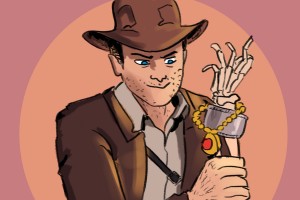Archaeology a form of grave robbing


As the daughter of an archaeologist specializing in North American archaeology, I spent a lot of time in labs and offices full of artifacts from different native groups and got to handle history firsthand when I would join my dad on archaeological digs. I have always had a fascination with history and things that come from the past; unlike my father, my interests in the past have always leaned towards the classical era, meaning Greek, Roman and Egyptian history, though I certainly enjoy reading about other groups as well.
After a recent trip to Mexico, I had the opportunity to see an ancient pyramid complex up close; I started to think about what certain aspects of archaeology and finding artifacts really meant to me.
While on the trip, my mom and I visited the Canada de la Virgen ruins near San Miguel and our tour guide explained the site’s history. He told us that the people who had lived at the site had, before abandoning it, covered it all up so that it looked like a great mound of dirt and dust so it wouldn’t be disturbed.
Even 50 years prior, people could ride to the top on horseback and wouldn’t even know what truly stood beneath their feet. They had found many amazing things there, including a body wrapped in an elaborate shroud that had been deemed royal and many fantastic artifacts; now, this got me thinking, but I didn’t really come to any conclusions until he invited us to climb the pyramid and explore a bit.
Archaeology is the study of human history and prehistory through the excavation of sites and through analyzing artifacts and other physical remains. And these peoples had their rituals to handle the artifacts and bodies of their dead.
The Egyptians (and the peoples who settled the area around Canada de la Virgen, though not to the same extent or in the same context) placed the bodies of the most important people in the pyramids with things for the departed to use in the next life. Then, the pyramids were sealed until some archaeologists came in and opened them up, proceeding to take whatever they could out of them, including the bodies, and place them in museums and various collections across the globe.
You can understand how I felt when the tour guide asked us if we wanted to climb the pyramid. The people at Canada de la Virgen had a reason for covering everything up, the Egyptians had their reasons for completely sealing the pyramids; and to me, it feels like a violation of the space when people are going in and taking out the treasures and bodies that were left in the tombs, or climbing all over things that are considered sacred space. I don’t think those who were buried there would be pleased to know that they were stolen from their final resting place and placed in a glass box for the world to see along with all their belongings, or that their burial site is constantly being violated by tourists and archaeologists.
This area of archaeology is pretty much a form of grave robbing, though it’s 100 per cent legal. While I don’t condone grave robbing at all, how is it legal for ancient burial sites or tombs but illegal for small, individual graves?
I really respect the kind of archaeology that my dad does. When they find burial sites, they consult with the group that the site could belong to before anything is done. After a Wendat ossuary was discovered in Midland, Ontario in 2003, the archaeologists at my dad’s firm worked with native elders and chiefs to ensure that the bones were treated with respect. While I understand that it is not possible for archaeologists to track down and consult people who are the descendants of those who lived over 2,000 years ago, I think that any sort of remains found should be treated with respect and be re-interred after they are discovered, not placed in museums.
These ancient peoples had their reasons for covering up the sites, and to me, what’s dead and buried should stay dead and buried, or at least be re-interred once any sort of usable data or important artifacts have been collected.
*Editor’s Note: The headline has been updated since its original publishing date.*

